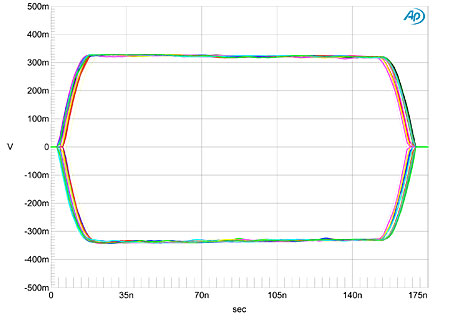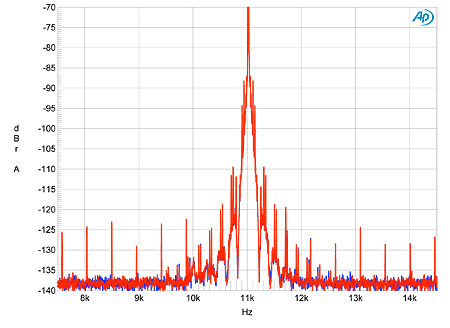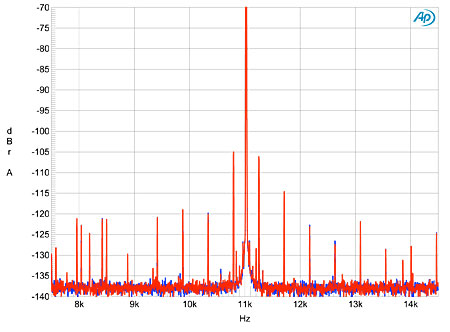| Columns Retired Columns & Blogs |
Lindemann & Stello USB-S/PDIF converters Measurements
Sidebar 3: Measurements
I examined the measured behaviors of the Stello and Lindemann USB converters using the Audio Precision SYS2722 system (see www.ap.com and "As We See It" in the January 2008 issue), as well as the Miller Audio Research Jitter Analyzer. I played back test tones at various sample rates and bit depths from BIAS Peak Pro 6 on a Mac mini running OS10.4.11, with some tests repeated on a dual-core PC running Windows 7 and Adobe Audition 3.0.
To check whether either USB link was bit-transparent, I fed its S/PDIF output to an RME soundcard fitted to a second PC and recorded the data using Adobe Audition. Playing back that recording simultaneously with an inverted, bit-synchronized version of the original audio file, there was a perfect null with both the Lindemann and Stello units with both 16-bit and 24-bit data. Both converters are therefore bit-transparent.
Using RME's DIGICheck utility, I looked at how many bits were active in each converter's S/PDIF outputs: with both units, the number of active bits followed how many had been set in the Mac's Audio Midi Setup utility or the PC's Audio Devices–Properties dialog: 16 or 24, as appropriate. Both also correctly handled the audio file's sample rate, again provided that the sample rate had been set with Audio Midi Setup on the Mac or Audio Devices–Properties on the PC, with the exception that neither would permit the selection of the 88.2kHz sample rate.
When I measured the Bel Canto USB Link 24/96, I looked at the quality of its digital output by connecting it to one of the Audio Precision SYS2722's S/PDIF inputs. The jitter was a fairly high 5.85 nanoseconds peak, and the "eye pattern" of the data waveform correspondingly showed some uncertainty at its starts and finishes. I have had the SYS2722 upgraded and recalibrated since that May 2009 review; looking again at the Bel Canto's S/PDIF jitter, I now get 2.91ns peak, which is still fairly high, and the eye pattern still shows some blurring at the beginning and end (fig.1).

Fig.1 Bel Canto USB Link 24/96, eye pattern of S/PDIF data output carrying 16-bit J-Test signal (±500mV vertical scale, 175ns horizontal scale).
By contrast, both the Lindemann and Stello converters (with their volume controls set to do nothing) gave significantly lower levels of datastream jitter: 444 picoseconds (0.444ns) and 395ps (0.395ns), respectively, and their eye patterns were open and well defined. Fig.2 shows the Lindemann's, which was identical to the Stello's, other than a slightly higher amplitude.

Fig.2 Lindemann USB-DDC 24/96, eye pattern of S/PDIF data output carrying 16-bit J-Test signal (±500mV vertical scale, 175ns horizontal scale).
I looked at the effects of datastream jitter in the reconstructed analog signal with a Musical Fidelity X-24K D/A processor, sourcing 16-bit J-Test audio data from the Mac mini's USB output via the converters under test and connecting each to the Musical Fidelity with a 9" Stereovox datalink. The X-24K offers only moderate rejection of incoming datastream jitter and has a noise floor with each FFT bin at the –140dBFS level, about 6dB lower than the Compact Disc's theoretical limit.
The spectrum of the Bel Canto USB Link 24/96's analog output showed significant broadening of the central peak that represents a high-level tone at exactly one-quarter the sample rate (fig.3), corresponding to the presence of low-frequency random variations of the sample rate; there were also sidebands of unknown origin at ±78 and ±122Hz. The Miller Analyzer calculated the jitter level to be a high 4.57ns peak–peak; as I wrote in my original review, it is important for the Bel Canto to be used with a DAC offering superb jitter rejection.

Fig.3 Musical Fidelity X-24K, high-resolution jitter spectrum of analog output signal, 11.025kHz at –6dBFS, sampled at 44.1kHz with LSB toggled at 229Hz, S/PDIF data from Bel Canto USB Link 24/96. Center frequency of trace, 11.025kHz; frequency range, ±3.5kHz (left channel blue, right red).
Fig.4 shows a spectral analysis of the Musical Fidelity's analog output while it was fed S/PDIF data from the Lindemann USB-DDC. The jitter level has dropped to a low 270ps p–p, and the spectrum is much cleaner than with the Bel Canto USB Link. There is some accentuation of the data-related sidebands at ±229Hz, however, and some other low-frequency sidebands can be seen.

Fig.4 Musical Fidelity X-24K, high-resolution jitter spectrum of analog output signal, 11.025kHz at –6dBFS, sampled at 44.1kHz with LSB toggled at 229Hz, S/PDIF data from Lindemann USB-DDC 24/96. Center frequency of trace, 11.025kHz; frequency range, ±3.5kHz (left channel blue, right red).
Finally, fig.5 shows the X-24K's output spectrum driven by the Stello U2. The sidebands at ±229Hz are higher than with the Lindemann, which is why the Miller Analyzer measured 455ps p–p of jitter, but the noise floor is significantly cleaner than with the German data converter. Possibly—just possibly—this is why I slightly preferred the Stello in my auditioning. But both the Lindemann USB-DDC 24/96 and the Stello U2 should be less fussy than the Bel Canto USB Link about the DACs with which they are used, at least regarding jitter rejection.—John Atkinson

Fig.5 Musical Fidelity X-24K, high-resolution jitter spectrum of analog output signal, 11.025kHz at –6dBFS, sampled at 44.1kHz with LSB toggled at 229Hz, S/PDIF data from Stello U2. Center frequency of trace, 11.025kHz; frequency range, ±3.5kHz (left channel blue, right red).
- Log in or register to post comments




































